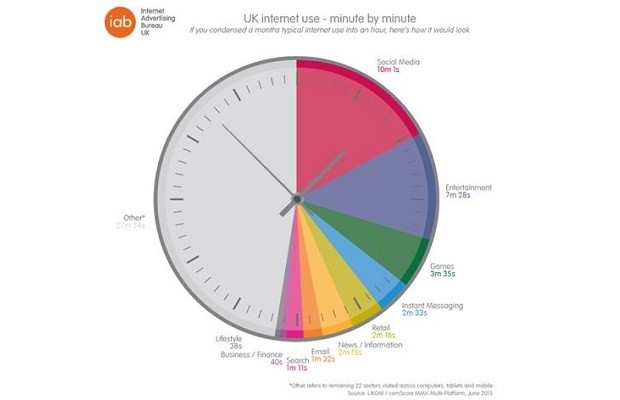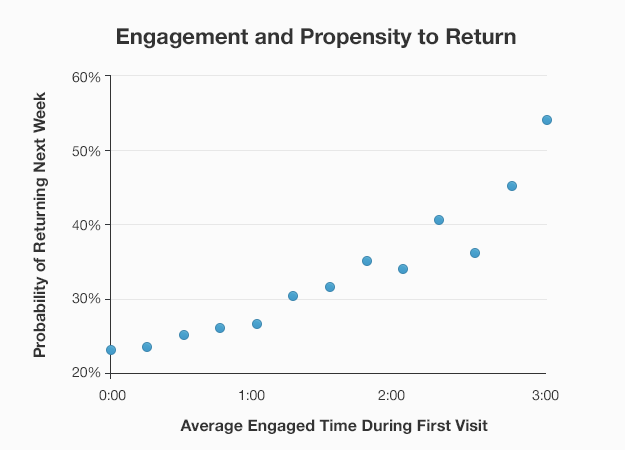How much time to do people spend online every day?
Answer: 2hrs 51 mins.
That’s the official figure from some serious research into the online behaviours of some 73,000 people conducted by Internet Advertising Bureau.
Nearly 3 hours – that’s quite a considerable amount of time, we think you’ll agree. And this research was conducted in 2015, so no doubt by now we’re spending even longer online.
But here’s the big question – how many of those 171 minutes are taken up reading our blogs?
Well, thankfully the IAB (in association with UKOM) study tells us that as well – and the answer is…. Not a lot.
Internet users in the UK are far more likely to be browsing social media than anything else, according to the figures. Indeed, 16.7% of all internet time is spent on social, with 12.4% devoted to entertainment, and 6% to games.
Only 3.75% of online time is spent consuming news and information (the category into which blogs fall) – which equates to an average of just 6 and a half minutes a day.

(Image source: iabuk.net)
Just 6 and a half minutes – that’s all bloggers have got to play with.
Granted, this 6.5-minute average is just an average – there will of course be plenty of people who spend much more time reading blogs… but also many who spend much less.
Either way, what we, as inbound marketers, have to contend with is the fact that the time people spend consuming blogs is evidently minimal. And so, we need a strategy to make sure that as many of those half-dozen minutes are spent reading our blogs every day as possible, and not someone else’s. That's where content marketing comes into play!
Does Engaged Reading Time Matter?
Yes. Yes, it does.
Web analytics company Chartbeat found that the greater the amount of time people spend reading an article, the more likely they are to come back later for more. The Chartbeat study was able to quantify this finding: “Visitors who read an article for three minutes returned twice as often as those who read for one minute.”

(Image source: blog.chartbeat.com)
Wow – so if we can keep readers engaged for just 3 measly minutes, we double our chances of their return.
That’s a serious statistic right there. And here’s another from the same article – “About two-thirds of visitors to an average site don’t return again in the next 30 days.”
Engaged reading time is shaping up to look like one of the most important metrics that inbound marketers need to consider. And, just to hammer this point home, in a separate study, Chartbeat also discovered positive correlation between longer reading times and brand recall.
Chatbeat conducted a test amongst 1,500 paid participants who were each given an article to read on a screen for a set time – ranging from 5 to 20 seconds – which featured an ad in the right hand rail. Participants were asked to read the article, and were told that they would be asked questions about its content afterwards. The only variable was the amount of time that people were given to read the article before the screen wiped blank.
The result? “Participants who read for 15 or more seconds were 25% more likely to recall the brand than those who read for 10 or fewer seconds.”

(Image source: blog.chartbeat.com)
Amazing.
So, even getting people to spend just 10 seconds longer on our blogs will help raise brand awareness (provided we keep our branding in-view, that is).
What we need now, then, are a few ideas for increasing this all-important engaged reading time on our blogs.
How to Increase Engaged Reading Time on Your Blog
Targeting
First thing’s first – if you want people to spend more time reading your blog, then you need to be targeting the right people.
And this begins with developing the right inbound marketing personas. What are inbound marketing personas? Quite simply – the detailed profiles of semi-fictionalised representations of your ideal customer (or, in this case, reader).
What types of blog content would this ideal reader want to consume for his or her 6.5 minutes of blog-reading time a day? What would be of most value to them? What topics are likely to interest them above all the other options that will present themselves on any given day?
Answer these questions thoroughly – and conduct market research, by all means – and craft your blog output accordingly.
Putting the Right Content in Front of the Right People
Once you’ve identified the most engaging topics to write about, the next stage will be to identify the exact people that you want to read it, and do everything you can to make sure they find this content.
And this means utilizing social media.
Consult your inbound marketing personas once more. Scrutinise the profiles, and match them up to members of your social media audience. Some will be on LinkedIn, others on Twitter, and still more maybe over at Google+. These are the right people who are most likely to want to spend a few minutes reading your carefully crafted content – so track them across social media, work out what times of day they are most active, and share your post at correlating moments, increasing the chances of clicks.
Another option is to target some of your identified leads directly through email marketing. Or you could perhaps even send these people a direct message containing a link to the article. However you do it, one of the most important factors of increasing engaged reading time is to make sure that you target those who are most likely to be engaged with the content in the first place.
Images and Sub-headers
People don’t read blogs like they do books or even newspapers. They tend to scan or scroll down a page, rather than reading every word.
However, what we’re trying to do here is encourage people to actually stop on our pages and read what we’ve got to say. And to do that, we need to halt them in their tracks when scanning – which means including plenty of images and sub-headers.
Sub-headers should be just revealing enough to make people want to pause and read the paragraph beneath, and images exciting enough as to infuse a sense of intrigue into the words that surround them. The idea is to create a blog post that is visually crafted in a way that makes people want to stop and find out more about what’s being said.
Include Estimated Reading Times
Yes, this is a great little trick that has gained in popularity over recent years.
If, at the top of the page, you inform visitors how many minutes it will take them to read your blog post, the evidence suggests that they’ll be more likely to read it.
It’s some sort of psychological trickery that seems to work. Marketing Land covers the subject in some detail, citing a software engineer who wrote:
“Do you ever glance at the scroll bar to see if a post is a huge essay or a quick hitter you can read while your code is compiling? Because I do all the time … even if you are only mildly interested in an article, if you know it’s only going to take 2 minutes to finish, you’ll stick it out.”

(Estimated reading time for this article according to Read-O-Matic)
Giving some slightly more measurable figures, the article also cites front end engineer Brian Cray, who remarks that by adding estimated reading times to the articles on his website, the overall time spent on his site improved by 13.8%. “What’s more interesting though,” he wrote, “people either followed me, subscribed to my blog or retweeted my articles 66.7% more often.”
What a result. Web developer David Michael Ross also experimented with the technique, and he too enjoyed favourable results, with his bounce rate dropping by 13%.
This definitely has to be worth a try. The average adult, according to the article, reads at a rate of between 200 and 250 words a minute, which leads to a pretty simple calculation:
Word count / 225 = number of minutes it takes to read an article
For the sake of good form and neatness, we would suggest rounding the resulting figure up or down to the nearest minute (i.e. in the case of 4.876 minutes, round up to 5 minutes, and so on).
However, there is an online tool that can do the calculation for you – Read-O-Meter. Just copy and paste your text into the provided field, hit the button, and receive your calculation.
Start Tracking Engaged Reading Time!
Engaged reading time is an incredibly valuable metric to track – and yet, according to a survey from Eloqua, only 27% of marketers are doing so. Seems like there’s room here to make some marginal gains on the engaged reading time front, and give your blog a competitive advantage. So, start targeting more vigorously, ensure you’re including plenty of engaging images, breaking your text up with sub-headers, and including estimated reading times at the tops of posts. Do all this, and your average engaged reading times should increase.










